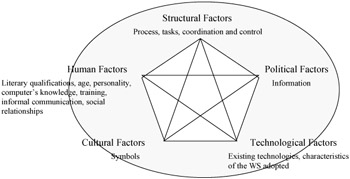Final Comments
|
|
It should be noted the factors described above are not isolated but interdependent. Moreover, we cannot say one is more important than the other, as they interact constantly. For example, although some of the existing technologies were obsolete and prevented the employee of the AFD from performing her job adequately, she was curious and committed enough to overcome her difficulties, even though her educational background is not as good as some of her colleagues. On the other hand, even those with a degree experienced some difficulties in performing their tasks and learning how to use the application, probably because these tasks were infrequent, rather than familiar routine. This problem was in turn exacerbated by the Metro application requiring users to register their satisfaction with the process before ending it, which, in such a small and simple process as this, constituted a constraining factor.
Although there was some dissatisfaction with the new application, the perceived predominant ethos of the company, which favours and encourages change, enhanced their willingness to adopt the new system and seems to have helped the staff overcome their difficulties. Any expressed dissatisfaction was counteracted by the unanimous recognition that the new WS did reduce paper volume, a welcome change.
Figure 5 represents the initial model used to study the impact of the WS on organisations presented in the first sections of this paper, and improved. It shows, not only the general factors that influence the use of a WS, but also the specific ones that mediated use in this particular case.

Figure 5: The Interaction Between the Organizational Factors
Thus, for instance, in structural factors, it should be taken into consideration the process involved, the characteristics of tasks as well as the coordination and control. For human factors, we have the literary qualifications, the age, the personality, the information literacy, the training and the relationships. As far as political factors are concerned, the access to information should be considered. In the technological factors, the use of a new technology can be influence by the characteristics of the existing technologies as well as those of the new system adopted. Finally, culture should also be considered, namely the symbols and the way the enterprise generally reacts towards change.
These factors, as shown in Figure 5, are interrelated and the results of such interaction evolve over time. Change is a process rather than an event (Orlikowski, 2002).
|
|
EAN: 2147483647
Pages: 186